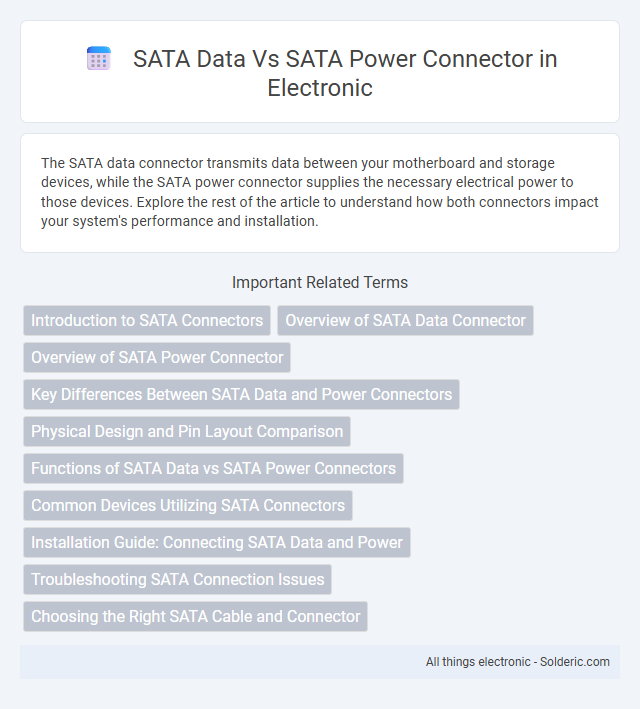The SATA data connector transmits data between your motherboard and storage devices, while the SATA power connector supplies the necessary electrical power to those devices. Explore the rest of the article to understand how both connectors impact your system's performance and installation.
Comparison Table
| Feature | SATA Data Connector | SATA Power Connector |
|---|---|---|
| Purpose | Transfers data between motherboard and storage devices | Supplies electrical power to SATA storage devices |
| Pin Count | 7 pins | 15 pins |
| Voltage Supply | Data signals only, no power | Provides 3.3V, 5V, and 12V power lines |
| Connector Shape | Flat, L-shaped key for correct orientation | Wider, L-shaped with distinct pin layout |
| Data Transfer | Supports up to 6 Gbps (SATA III) | Not applicable |
| Common Use | Connecting hard drives, SSDs, optical drives to motherboard | Powering hard drives, SSDs, optical drives, SATA devices |
Introduction to SATA Connectors
SATA connectors consist of two distinct types: the SATA data connector, responsible for transmitting data between the motherboard and storage devices, and the SATA power connector, which supplies electrical power to these devices. The SATA data connector is typically smaller, featuring a 7-pin design, while the SATA power connector is larger with 15 pins, delivering multiple voltage levels (3.3V, 5V, and 12V) essential for device operation. Understanding the difference between these connectors ensures your storage devices are properly connected and powered, optimizing performance and reliability.
Overview of SATA Data Connector
The SATA data connector transmits data between the motherboard and storage devices such as hard drives and SSDs, featuring a slim 7-pin interface designed for high-speed serial communication up to 6 Gbps with SATA III standards. Its distinct L-shaped key prevents incorrect connections and supports features like hot swapping and native command queuing to enhance performance and reliability. Unlike the 15-pin SATA power connector, which supplies electrical power, the data connector solely manages data transfer within SATA storage systems.
Overview of SATA Power Connector
The SATA power connector supplies electrical power to storage devices such as SSDs and HDDs, featuring 15 pins that deliver 3.3V, 5V, and 12V lines along with ground connections to ensure stable power distribution. Unlike the SATA data connector, which handles data transfer at speeds up to 6 Gb/s, the power connector is specifically designed to handle multiple voltage levels necessary for device operation. Your system's reliability depends on a properly connected SATA power cable that supports efficient power delivery and device longevity.
Key Differences Between SATA Data and Power Connectors
SATA data connectors transmit data between storage devices and the motherboard, featuring 7 pins dedicated to high-speed data transfer. SATA power connectors supply electrical power to the drives, consisting of 15 pins that deliver 3.3V, 5V, and 12V power lines. Understanding these distinct functions ensures you correctly connect Your storage devices for optimal performance and reliability.
Physical Design and Pin Layout Comparison
The SATA data connector features a slim, 7-pin design specifically meant for high-speed data transfer between a storage device and the motherboard, with a distinctive L-shaped key to prevent incorrect connections. In contrast, the SATA power connector is larger, with 15 pins arranged to deliver three different voltages (3.3V, 5V, and 12V) along with multiple ground pins, ensuring stable power supply to the device. This physical and pin layout differentiation enables the separate handling of data transmission and power delivery in SATA drives, optimizing both performance and reliability.
Functions of SATA Data vs SATA Power Connectors
SATA data connectors transmit digital signals between the motherboard and storage devices to facilitate data transfer. SATA power connectors supply electrical power to hard drives or SSDs by delivering various voltage levels necessary for device operation. Together, these connectors ensure both communication and power delivery for reliable storage device functionality.
Common Devices Utilizing SATA Connectors
SATA data connectors are primarily used in devices like hard disk drives (HDDs), solid-state drives (SSDs), and optical drives for data transfer between the storage device and the motherboard. SATA power connectors supply electrical power to these storage devices, ensuring proper operation through the power delivery interface from the power supply unit (PSU). Common devices utilizing SATA connectors include desktop computers, laptops, gaming consoles, and external storage solutions that rely on efficient data communication and stable power supply.
Installation Guide: Connecting SATA Data and Power
When installing your SATA devices, connect the SATA data cable from the motherboard or SATA controller directly to the SATA data port on your HDD or SSD, ensuring a secure and snug fit for reliable data transfer. The SATA power connector, supplied from the power supply unit (PSU), should be plugged into the corresponding power port on the drive, delivering the necessary electrical power for operation. Proper alignment and gentle insertion prevent damage and ensure your storage device functions optimally.
Troubleshooting SATA Connection Issues
SATA data and SATA power connectors serve distinct functions, with the data connector transmitting information between the motherboard and storage device, while the power connector supplies electrical power. Troubleshooting SATA connection issues often involves verifying the integrity of both connectors by ensuring the data cable is firmly attached and free from damage, and that the power connector delivers consistent voltage from the power supply unit. Testing with known working SATA data and power cables and checking for bent pins can quickly identify the root cause of connectivity problems affecting hard drives or SSDs.
Choosing the Right SATA Cable and Connector
Choosing the right SATA cable and connector involves understanding the distinct functions of SATA data and SATA power connectors. SATA data cables transmit data between your motherboard and storage devices with a narrow 7-pin design, while SATA power connectors provide electrical power via a wider 15-pin interface. Ensuring you use compatible cables and connectors tailored to your device's specifications is essential for optimal performance and reliability.
SATA data vs SATA power connector Infographic

 solderic.com
solderic.com